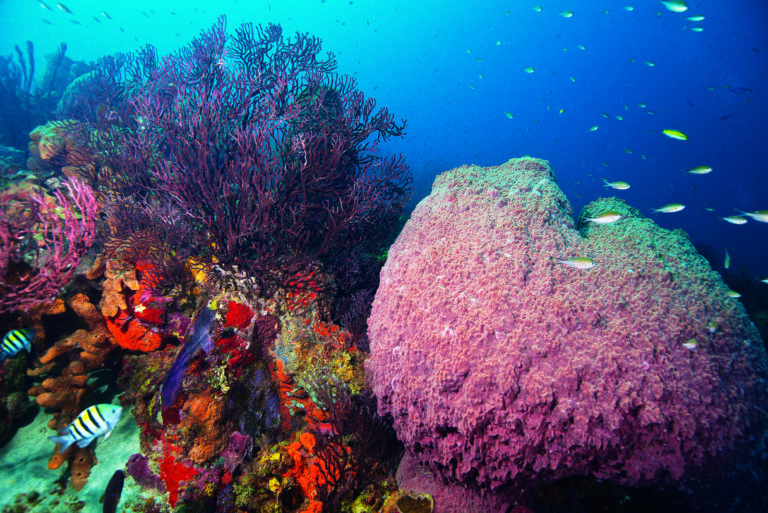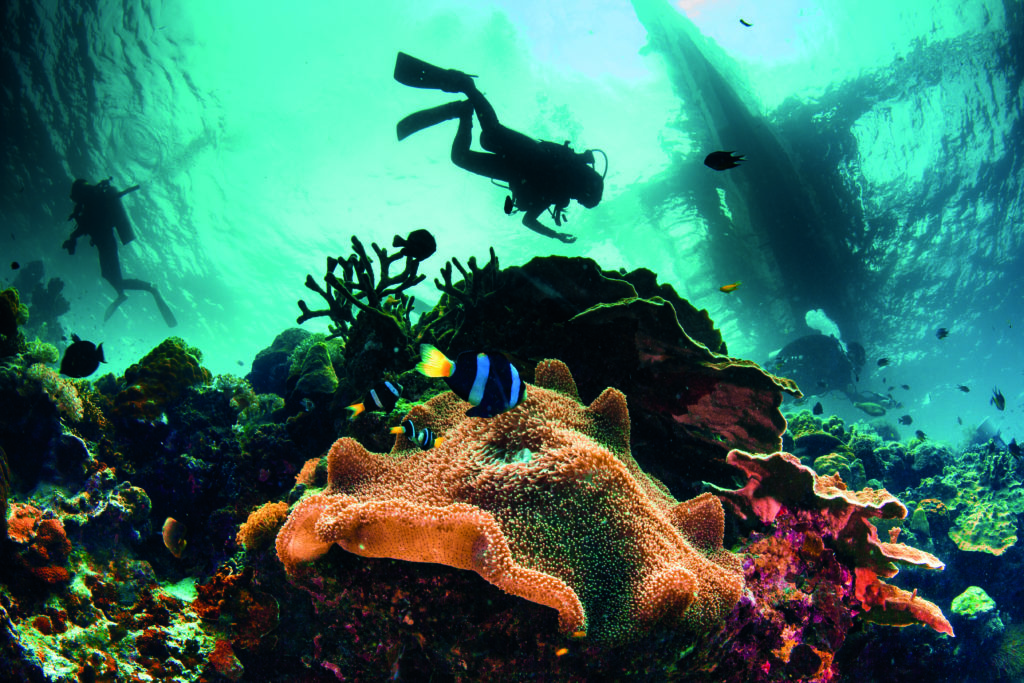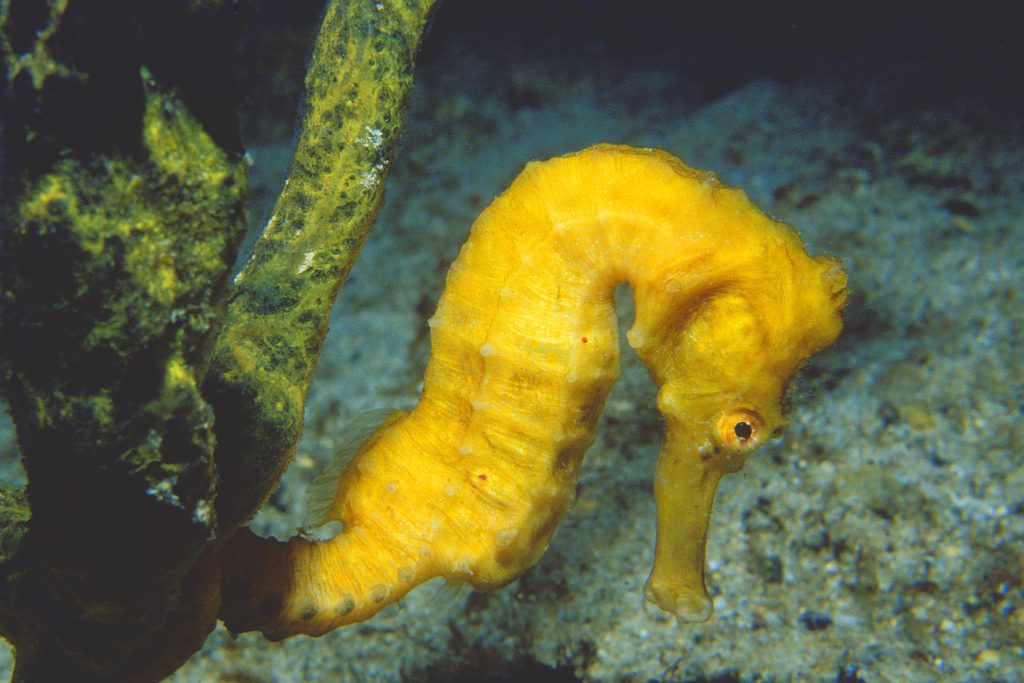He might have travelled to dive all over the Caribbean, but AL HORNSBY didn’t stop him being seduced by the natural attractions of St Lucia both above and below the surface.
Arriving in St Lucia, one of the British Windward Islands that arch through the south-eastern Caribbean Sea, is a visual treat, as the rugged, jungle-covered volcanic isle rises steeply from a cobalt ocean.
The interior is rainforest, with stands of hugely girthed trees dotted with massive volcanic cones. The island is regarded as one of the most beautiful places in the Caribbean for boat dives.

For most visitors, especially divers, the first order of business will be an hour’s drive from the airport to the main tourist-diving area along the southern west coast. It takes you past local towns and through some of the very scenic mountain areas. Rather than a chore to be endured after a long flight, for most visitors t is an eye-opening introduction to what St Lucia has to offer.
Emerging from the forest, your first view of the blue and turquoise sea, with its fringing, golden beaches and swaying palms, is breath-taking. Nearing the coastline towards the town of Soufriere, which sits at the waterside in the Soufriere Marine Management Area where most of the best-known dive-sites are located, the scenery is majestic
The vista becomes dominated by two towering volcanic spires rising at the water’s edge, the 743m Petit Piton and, beyond it, Gros Piton, reaching 771m.
Therein lies a pleasant conflict – even for the most ardent diver, it soon becomes obvious that some time will have to be set aside to explore this enchanting place. After all, there are jungled hiking trails up both Pitons and to the island’s tallest peak, 950m-high Mount Gimie, where, if lucky, you could spot St Lucia parrots and dazzling hummingbirds, and hear the remarkable songs of the St Lucia warbler.
You can also visit the Caribbean’s only “drive-in volcano”, where you can soak in the hot (45°C) mud of its bubbling, sulphur springs. You can explore the local Creole culture which, since the beginning of the 16th century, has absorbed French, African, Dutch and English influences, with its marvellous expressions in food (St Lucia is famous for its cooking), song and art.
Fortunately, especially because the dive routine is so convenient, with super-quick trips out when boat-diving and some great off-the-beach diving spots, even doing several dives a day can leave time for topside pursuits. Or time to enjoy the famed and unique St Lucia rum punch.
St Lucia dive-sites
All these pleasures aside, it’s the diving that brings folks like us to St Lucia and it’s something special. For the American diving community, St Lucia found its fame in the early 1980s as an out-of-the-mainstream destination especially popular with diving photographers, at a time when diving was not particularly known in this part of the Caribbean.
Then, as now, underwater exploration featured beautiful, life-filled reefs, sea-mounts and walls in calm, protected waters. Just off the beach in quiet coves, grass beds and coral flats teemed with macro and small critters such as seahorses, flying gurnards, snake eels, octopuses and more.
With many sites to choose from, some of my favourites are:
Grand Caille
Just north of Soufriere, Grand Caille is a large, sprawling reef that slopes from the shallows into deep water. It is practically covered with orange, red and encrusting sponges and large barrel sponges, coral mounds and stands of purple, deepwater gorgonians.
Swirling above the reef are clouds of damselfish, and around the bottom are many reef species, including porcupinefish, angelfish and butterflyfish.
Especially numerous are common lionfish, the invasive Pacific and Indian Ocean species that has made its way into the Caribbean in recent years. With few natural predators in these waters they seem fearless, and appear to nonchalantly pose for images, unperturbed by divers and their strobe flashes.
Wreck of the Lesleen M
Just a north of Grand Caille, the wreck of the 49m freighter Lesleen M sits on a 20m sand bottom, its superstructure at only 12m. It is colourful and loaded with schooling fish, which congregate inside the easily entered upper deck areas. We saw squirrelfish, bigeyes, small tomtate grunt, goatfish, snapper and individual trumpetfish, in numbers.
Brightly hued gorgonians hung from the ceilings and passageways, encrusting and tube sponges grew in profusion, and blue runners and jack circled about. Down on the sand near the hull were a number of garden eels and several small southern sting rays. This is an interesting, easy wreck-dive, well-lit for photography.
Pinnacles
Another nearby site is Pinnacles, four seamounts that rise from deep water to near the surface. This is one of St Lucia’s most dramatic dive-sites; in very clear water, the spires are covered in black and orange gorgonians and large sponges and surrounded by schooling snapper and jack.
Grouper are seen along the rocky surfaces, and brightly coloured crinoids in surprising numbers extend their arms out from crevices. Green turtles are frequently seen, along with resident barracuda. Dive profiles – starting as deep as you would want, then meandering around the spires on an ever-ascending trajectory – are ideal, never wasting a moment of bottom-time.
Superman
Probably my favourite St Lucia site is Superman, an exciting current drift-dive that runs along the base of Petit Piton where it dramatically rears up from the sea. Mamed for a down-the-face fly-by in the Superman II movie filmed here, especially when the current is up, divers are provided fly-bys of their own, along the steep underwater wall of the piton.
An especially rich area for macro photography, the wall has masses of gorgonians, sponges and corals, with lots of fish moving about. In the many crevices that splinter the volcanic rock it was easy to tuck in, out of the current, to find smaller life and even comfortably shoot macro (which I did on one dive).
The small life was remarkable, with more arrow crabs than I have ever seen, not hidden in holes in the reef but wandering about in the open, unusual in daylight hours.
There were a number of different shrimp species, including banded coral shrimp and brilliantly coloured Pederson cleaner shrimp, equally unperturbed by our presence.
Notably, there were surprising numbers of smooth trunkfish meandering on the seabed, looking out for small crabs, shrimp and gastropods to eat. Also remarkable were the large numbers of featherduster worms, which seemed to flare out everywhere from openings in the many sponges that grew about the bottom; and bright, almost luminescent-pink vase sponges, seen at practically every turn.
Anse Chastanet Reef
By all accounts St Lucia’s original popular dive-site, this lovely spot begins just off the beach in the cove that is the home of the popular Anse Chastanet Resort. Its existence was not only been one of the keys to popularising St Lucia diving from the early 1980s, but remains an aspect of the easy, no-lost-time dive availability that helps makes St Lucia unique (and helps provide the time to enjoy the island’s many topside activities as mentioned earier).
With PADI 5* dive-centre Scuba St Lucia located there at the water’s edge a dive, whether early in the morning, between boat-dives, in late afternoon or after sunset, and at all times in between, is a matter of suiting up along the low wall between the centre and the water, taking a few steps across the sand, and – voila – you’re on a dive.
The underwater terrain, in flat-calm, clear water, begins as sand and quickly changes to patch-reef just a few metres offshore (or grass-bed, depending on which direction you head, and what kind of marine life you seek).
Ideal as an easy dive, with depths eventually extending down past 30m along the coral-covered slope, it is special for macro photography in the shallows, and for larger fish and turtles among the corals as you get deeper. The bright, calm conditions also suit the site to snorkelling.
In two quick, between-boat-dive dives there, we saw octopuses, a peacock flounder, goldspotted snake eels, two species of tilefish, juvenile boxfish, trumpetfish and many more species (some quite unusual for broad daylight) as we searched the grass-bed and the edge of the reef in less than 6m of water.
I’m told that the night-dive critter-finding is particularly good. There were two, special species common to the reef that we didn’t get to see this trip, however, the slender seahorse and the flying gurnard (next time).
Photographs by Al Hornsby
Also on Divernet: World Of Sponge, Coral Spawning St Lucia Style






